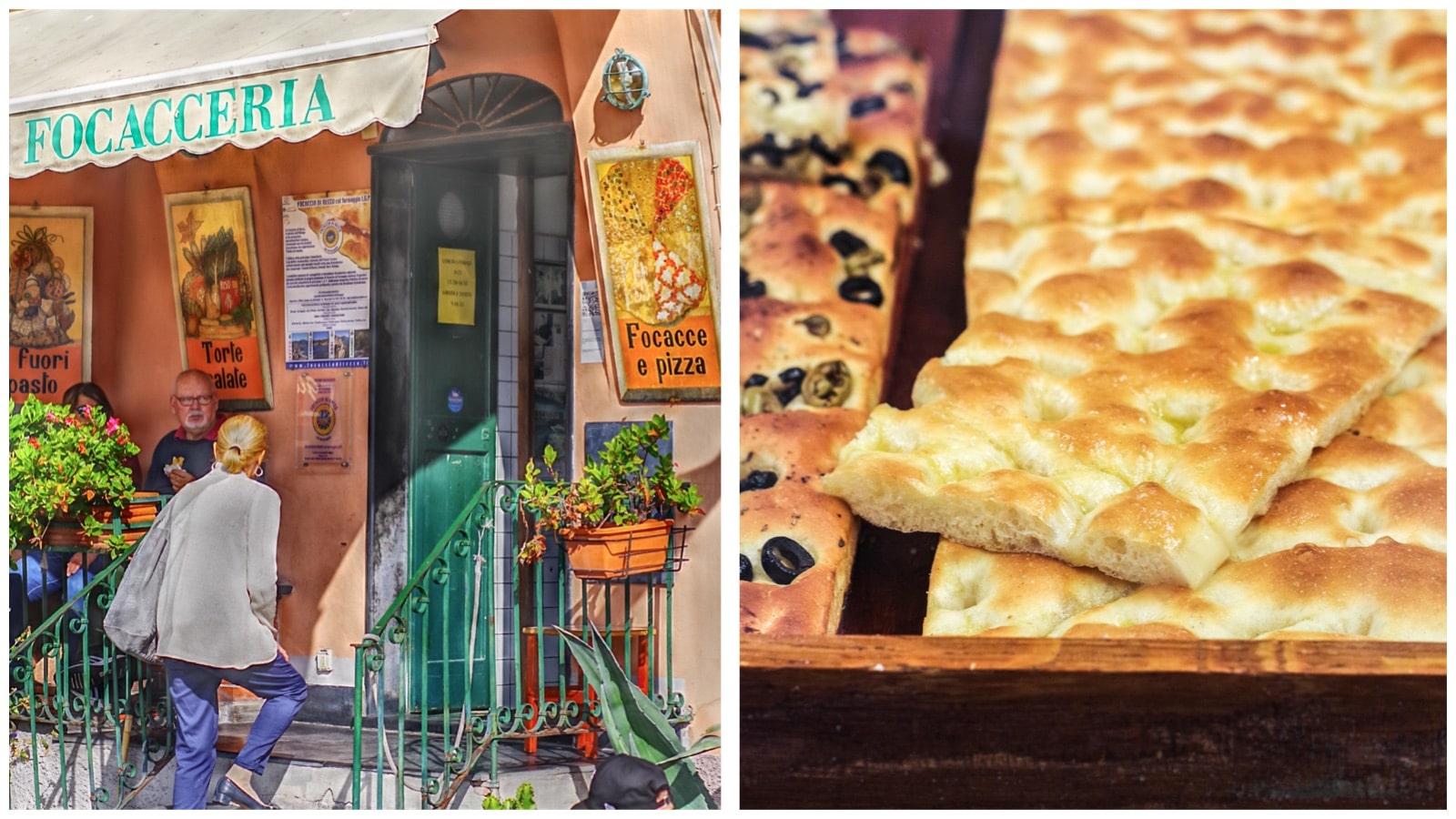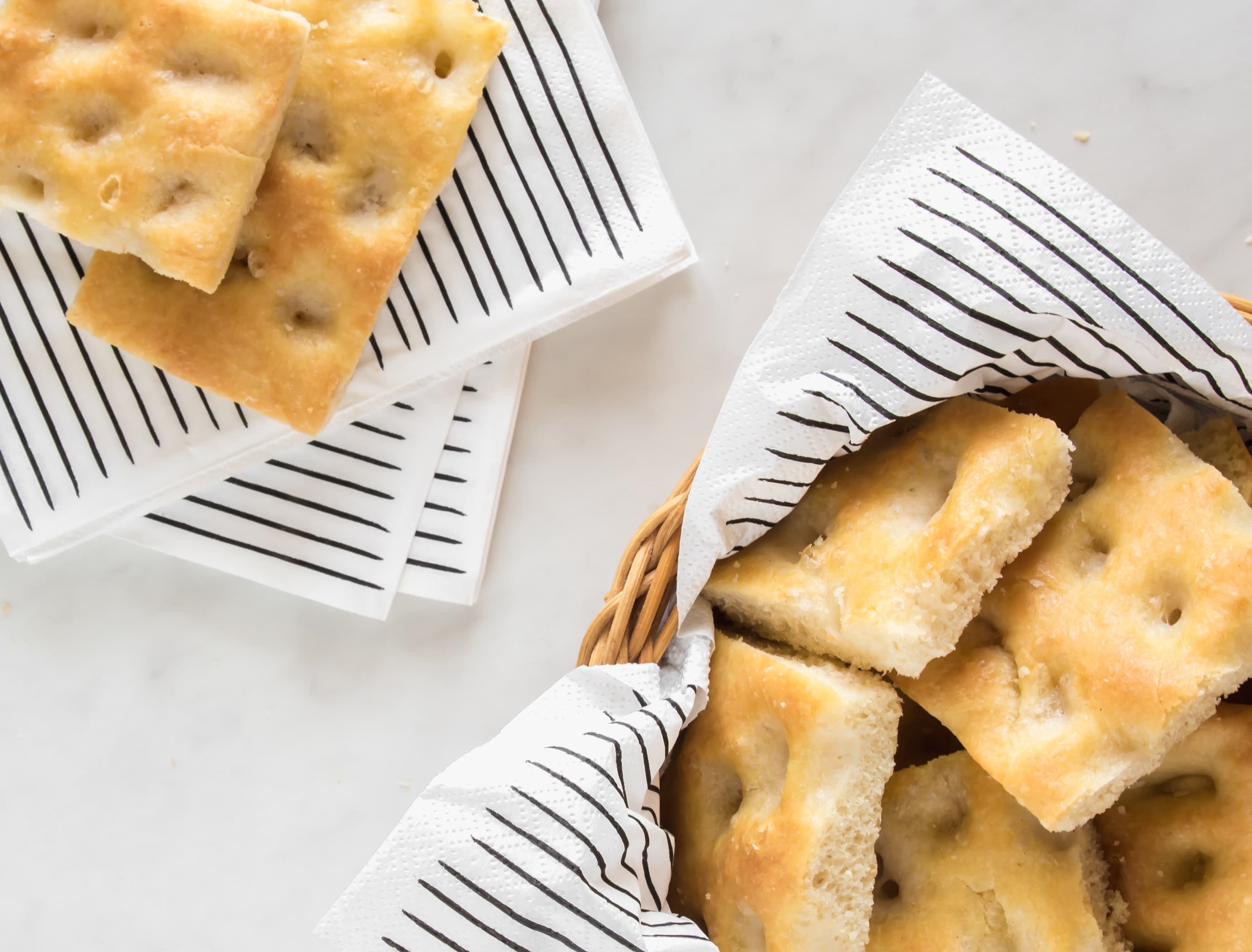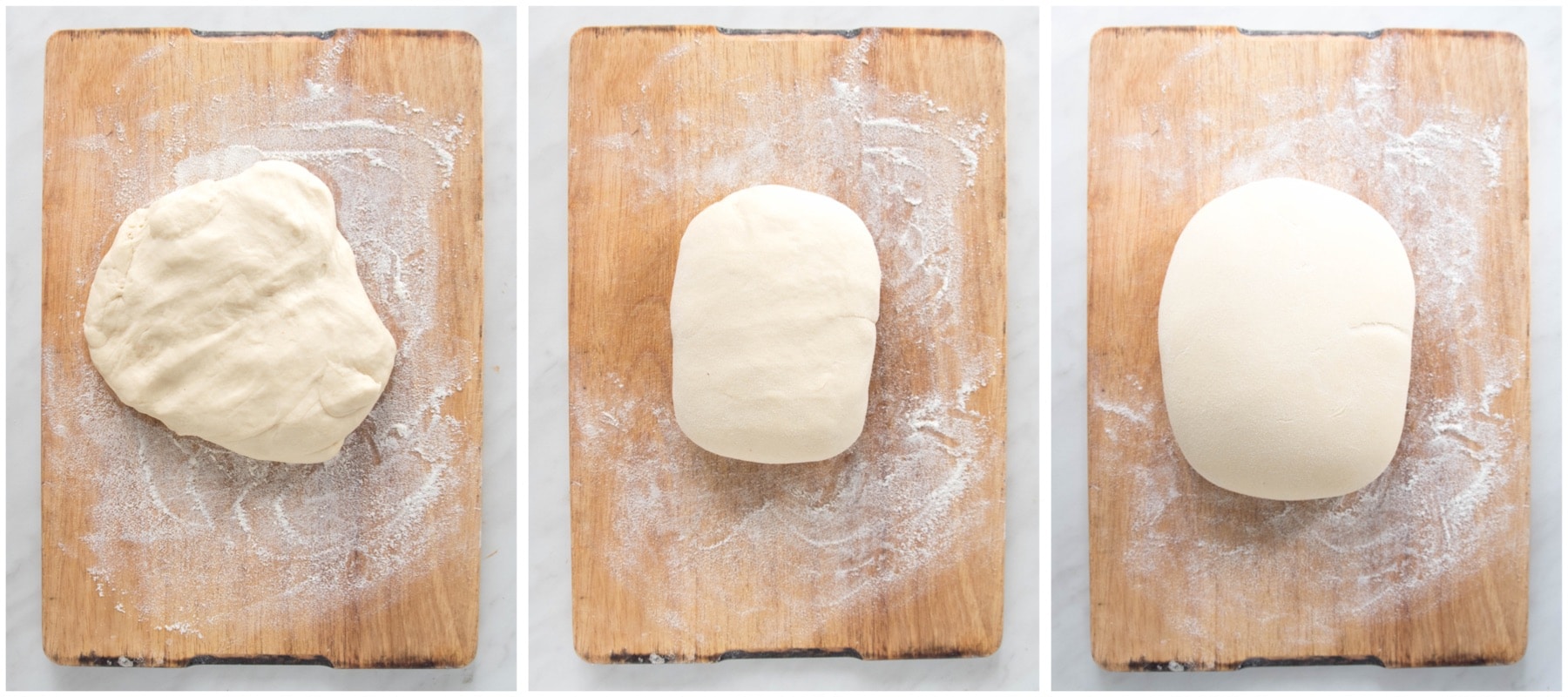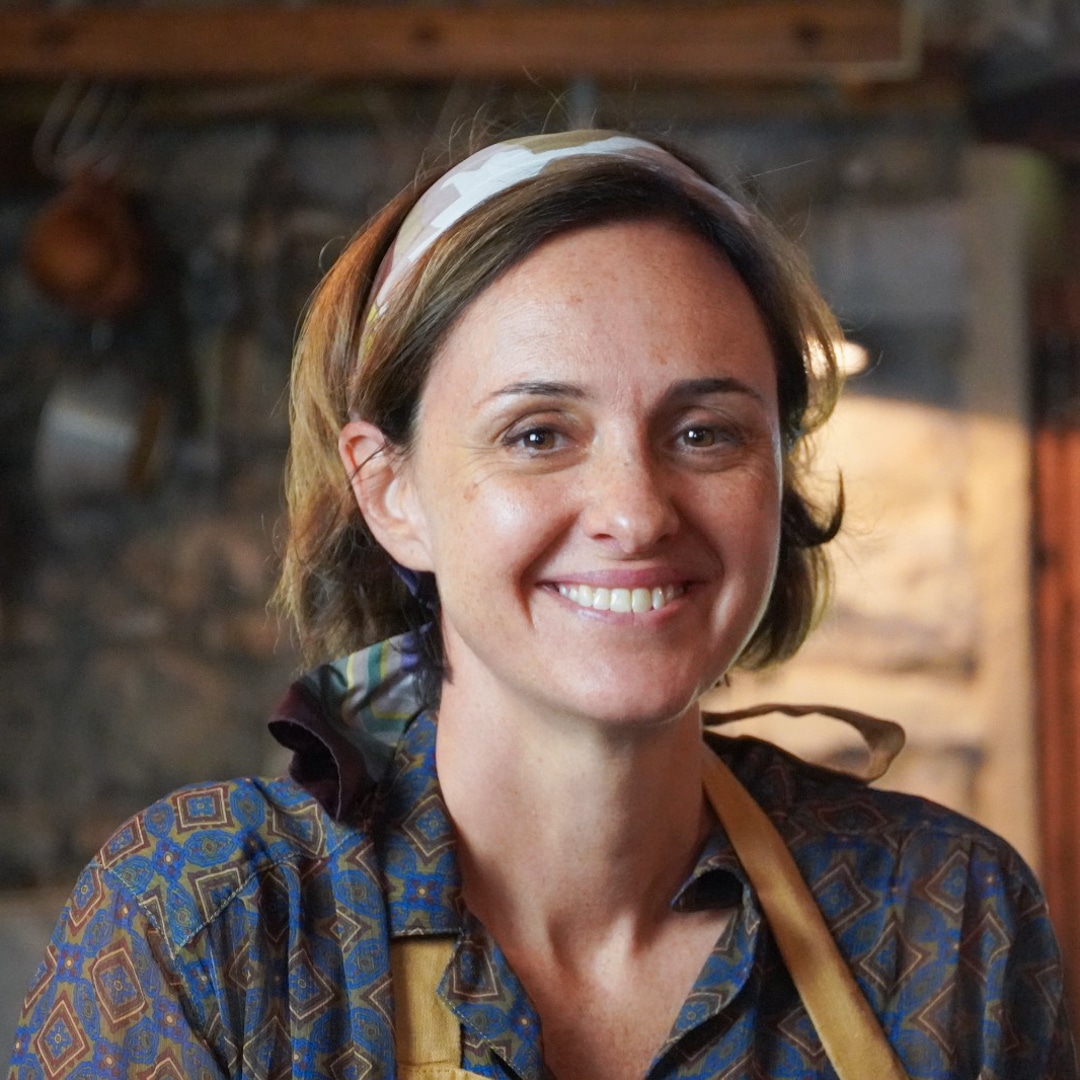
Focaccia in Genoa is ubiquitous. It is in our life from sunrise to sunset. We soak it in the cappuccino for breakfast (yes, we do, and it’s incredibly good), we give it to our children as a snack at school, at lunch goes hand in hand with bread in the basket, it is offered at parties and finally with a glass of white wine for aperitivo.
In the Middle Ages it was the convivial bread par excellence. It was eaten in church during marriages and then also during funerals (which in the long run annoyed the clergy that ended up forbidding its consumption in church).
In Genoa, focaccia sells like hot-cakes. Everybody buy at least a slice of focaccia together with their daily bread. The bakeries bake it from the very first hours of the morning and continue nonstop until mid-afternoon. Because Genoese focaccia gives its best freshly baked – ephemeral, like all good things, it does not remain fragrant more than one day – and Genoeses know this so they can wait silently in the store even 10 minutes to put their hands on a piece of focaccia sizzling with oil. Then normally less than a half will arrive at home because the rest will be devoured – more or less consciously – along the way, thanks to the fact that the bag, if the focaccia is hot, must remain open otherwise it soften, and you can imagine the scent that goes up straight to the nostrils…

Since every bakery, pizza shop, bar or sciamadda(typical Genoese gastronomy) in Genoa sells Genoese focaccia, how to recognize a good one? If you buy it in a bakery, in the early in the morning and still hot you are already on track. But you can recognize perfect focaccia because it is thin (maximum 2 cm thick), it is studded with holes (called “œggi”, eyes) with a white and creamy center (the cream is formed by flour, water, salt and oil that are poured on the surface just before the oven), it is golden and bright with oil (focaccia must almost leak oil), it is crispy outside and soft inside, salted on the surface and never sour (which happens if it is kneaded with poor olive oil).
Then there are variations on the theme, such as focaccia with onions (attention it creates dependence… and keeps people away), the one with sage or with rosemary and the one with olives. Then each bakery indulges on topping as they please, so there are focaccia with cherry tomatoes, others with various vegetables and so on.
The focaccia di Recco, instead, is a different product: it’s a savory pie typical of Recco (a small village on the coast close to Genoa) made of two very thin layers of unleavened dough containing a local fresh cheese melted.

.
The recipe of Genoese focaccia
If you have the right recipe, you can make a good Genoese focaccia also at home. It is important to follow the procedure step by step, to respect the various stages of leavening and to use an appropriate pan according to the amount of dough to bake. In the recipe below the ingredients are calculated to obtain a dough to be rolled into a rectangular aluminum pan with low sides measuring 30×40 cm.
But first some practical tips:
- the oil: I prefer not to use extra virgin olive oil (I know it sounds strange) which has a too marked flavor and risks to alter the final taste. It is better to use a good Italian olive oil and then brush the focaccia only once cooked with extra virgin olive oil.
- the holes: you shall made them using the fingertips of the three central fingers of your hand. The pressure must be marked (without breaking the dough, however) and as much as possible parallel to the surface. They must be many and very close to each other.
- leavening: always cover the dough with transparent film during leavening to avoid the surface getting dry.
- brine: the secret of Genoese focaccia is the emulsion of oil, water and salt that you spread abundantly on the surface before the last leavening. Do not worry if it seems a lot, it will evaporate during cooking and allow the holes to remain during cooking.

Ingredients
- 370 g flour
- 180 g of lukewarm water
- 7 g of salt
- 6 g of malt
- 8 g of brewer's yeast
- 18 g of olive oil
- 25 g of oil to grease the pan
- 2 tablespoons extra-virgin olive oil to brush the cooked focaccia
Instructions
- Pour flour, malt, salt and water (keeping about 5% to be added at the end of the dough) into the bowl of the kneading machine. Knead for five minutes at low speed.
- Add the crumbled brewer's yeast and, once incorporated, add the oil, always stirring at low speed.
- Once you have incorporated the oil (maybe you have use your hands) add the water left aside and continue to knead at medium speed for 6/7 minutes. The dough is perfect when pulling it by a flap is very elastic and difficult to tear.
- Pour the dough on the work surface, give a fold, form a slightly flattened rectangle and let it rest for 30 minutes on a floured board with the fold facing down covered with transparent film so that it does not dry on the surface and with a tea towel on top to keep it warm.
- After 30 minutes grease a rectangular baking pan (30 cm x 40 c) with 25 g of olive oil, roll the dough with a rolling pin taking care to keep the same shape of the pan but slightly smaller and then transfer the dough inside the pan (it should cover an area of about 70% of the pan).
- Let it raise for 30 minutes, always covered with transparent film. Then stretch the dough until you cover the entire surface of the pan leaving no edge free and taking care to eliminate various air bubbles below the dough.
- Let it rise again for 60 minutes, always covered with a transparent film.
- Dust abundantly with flour and make deep holes well close to each other using your fingertips (exclude the thumb and little finger and try to keep the palm of the hand as much as possible facing the surface).
- Pour 20 g of olive oil on the surface and 10/15 g of warm salted water (with 5% saline solution i.e. 5 g salt per 100 cc of water). Mix water and oil well with your fingers covering any area of the surface being careful that the water does not go under the surface.
- Let it rise for additional 60 minutes under a film in a warm place.
- Pre-heat the oven to 230°C (450°F) and bake for 15 minutes.
- As soon as the surface is golden remove the focaccia from the oven, turn it upside down, pull out of the pan and brush the bottom and the crust with extra-virgin olive oil.
- Let it cool on a cooling rack to keep it crispy.



.
Where to eat the best focaccia in Genoa?
Here are some bakeries in the center of Genoa whose Genoese focaccia – on my humble opinion – is worth trying. Then the last word is up to your taste!
In the historic center area:
- Focaccia e Dintorni (via Canneto il Curto 54-56)
- Panificio Claretta (via della Posta Vecchia 12)
- Antico forno della Casana (Vico della Casana 17 r)
- Antico Forno Patrone (via Ravecca 72r),
Mercato Orientale area:
- Panificio da Mario (Via San Vincenzo 61r)
- Panificio Santa Rita (via Colombo 40)
On the way to Principe train station
- Le Bontà del Grano (piazza del Carmine 11r)
Happy focaccia to everyone!
Did you like this recipe? Don’t miss the next ones!
Sign up to my NEWSLETTER!
[mc4wp_form id=”611″]
SHARING IS CARING!





